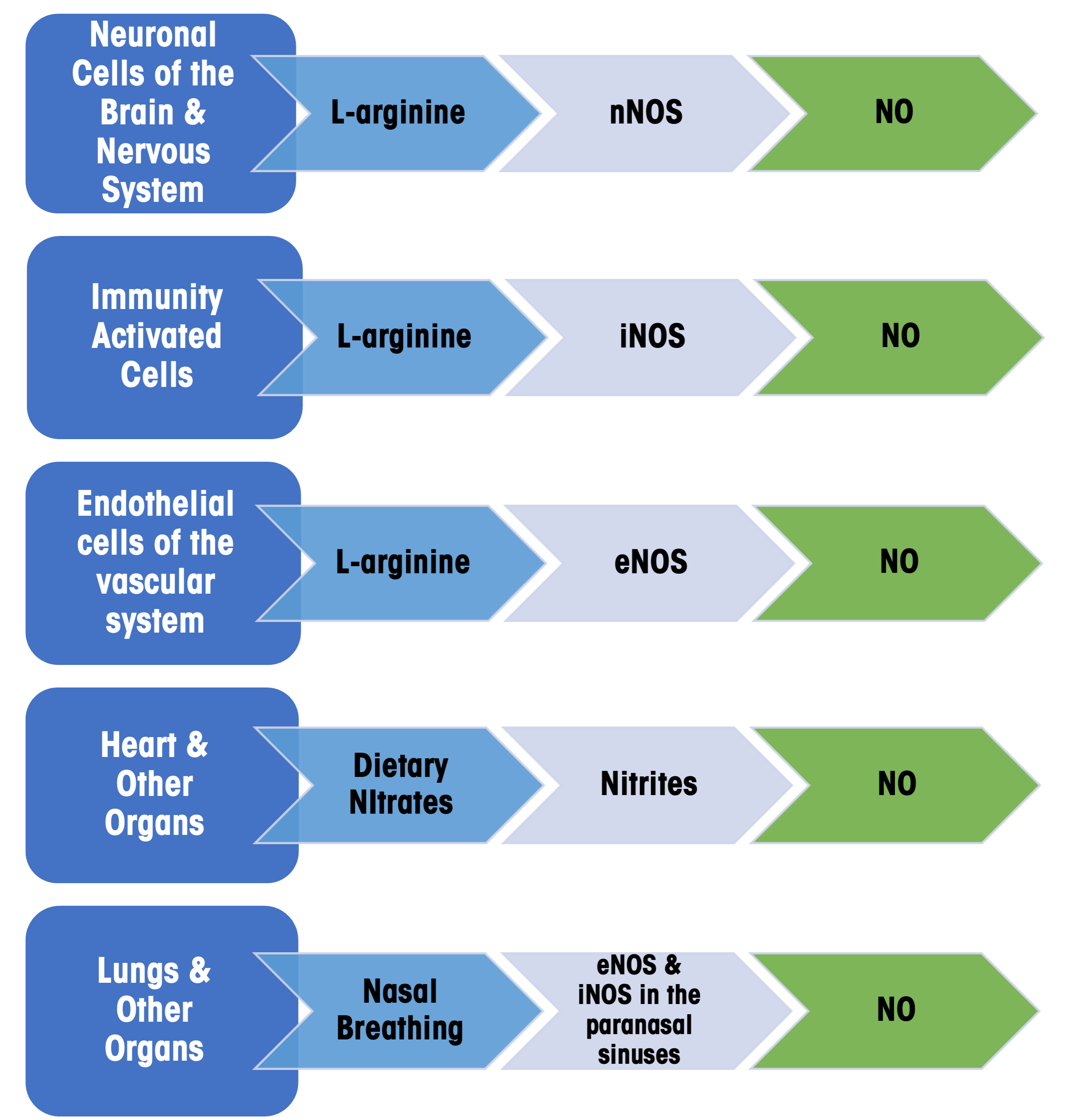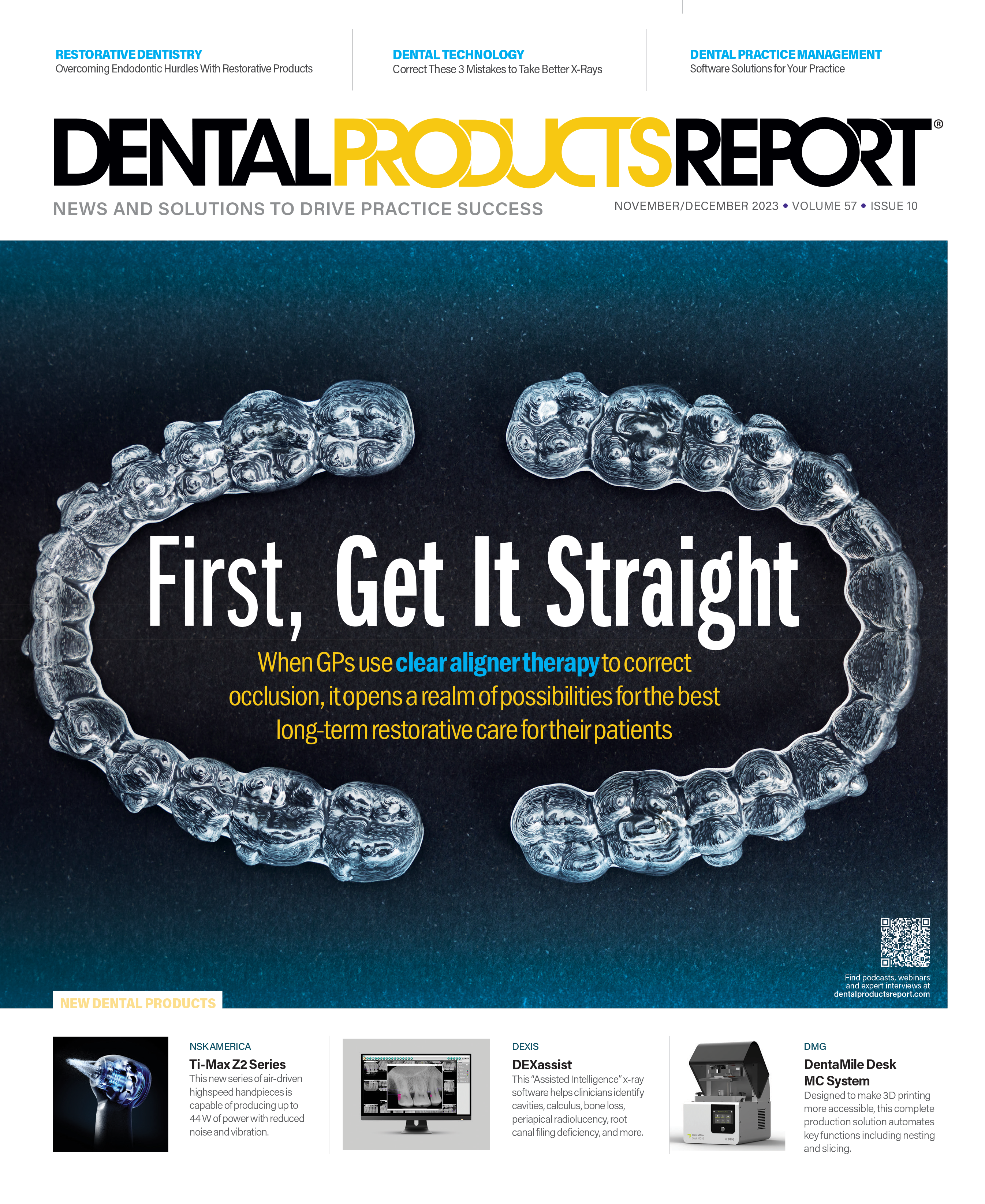Importance of Nitric Oxide – the Dental and Medical Connection
Understanding the health benefits of Nitric Oxide, and the biological processes by which it can be created, or destroyed is a key part of understanding the links between oral and systemic health.
Nitric oxide (NO) has been at the forefront of scientific research since 1998 when 3 US scientists, Robert F. Furchgott, Louis J. Ignarro, and Ferid Murad, won the Nobel Prize in Physiology or Medicine for discovering that NO is a powerful signaling molecule in the cardiovascular system.1 NO is not only a potent vasodilator, it also plays a part in the immune system and in neural transmission. Since this discovery, the media has occasionally promoted the purported benefits of NO supplements for improving virility and overall health.
Image Credit: © Metreco / stock.adobe.com

Still, NO is now known to be a major component for optimal health, and a lack of or deficiency of NO is the cause of many chronic disease processes.2 One unique way NO is produced is through symbiotic bacteria in the mouth. Dentists should be aware of this process and be able to discuss NO with their patients.
Additionally, it has been suggested that nasal breathing improves NO bioavailability and dentists should know the scientific basis for this. The goal of this paper is to explore the evidence of the benefits of NO, the consequences of decreased NO, and how to enhance NO production in dental patients. A secondary goal is to use this knowledge to aid the dental practitioner in educating patients about this important biological process.
Dentistry and NO
In 2017, the American Dental Association set out guidelines for dentists to screen for sleep related breathing disorders.3 Since then, dental sleep medicine has gained wide interest and many dentists seek to learn more about the consequences of obstructive sleep apnea (OSA). OSA is characterized by episodic reductions of airflow for 10 or more seconds caused by a collapse or total obstruction of the upper airway. Untreated OSA can lead to many adverse conditions such as hypertension, heart attack, stroke, gastroesophageal reflux disease (GERD), depression, obesity, diabetes mellitus, and hypercholesterolemia.4 It is important to note that NO bioavailability is compromised in all of these conditions.5
NO Physiology and Function
As a powerful signaling molecule in the cardiovascular system, NO dilates blood vessels and brings oxygen rich blood to the body, and in turn lowers blood pressure. Due to the nature of this vasodilation, NO improves athletic performance and brain tissue is further perfused with oxygen rich blood. Conversely, a deficiency of NO leads to decreased blood flow to the brain, organs, and extremities.
NO also plays a part in the immune system along with stem cells, macrophages, T-cells, and other pathogen fighting entities.6 Furthermore, NO acts as a neurotransmitter in the brain. Here it regulates synaptic plasticity, behavior, and cognitive function as well as blood flow. A lack of NO could lead to high blood pressure, increased risk of Alzheimer’s, and erectile dysfunction.2
NO is made in several ways. One is endogenously through endothelial cells which line every blood vessel in the body. Amino acids in the body L-arginine (Arg) and L-citrulline (Cit) are needed for this process. Arg is a semi-essential amino acid which is a NO substrate and Cit acts as an L-arginine precursor which is also converted to NO. In this pathway, NO synthase of the endothelial cells is utilized (eNOS) and intracellular calcium (Ca) concentration is decreased which relaxes smooth muscles producing a vasodilation effect.5
Arg is made in the body or found in various foods. This amino acid is used in many metabolic processes in the body and only a fraction of Arg is used in the NO synthase pathway.7 Cit is a non-essential amino acid, and interestingly, the only food found to contain Cit is watermelon. Arg and Cit are added to NO supplements in hopes to improve athletic performance and possibly lower blood pressure. Early studies have shown that Arg and Cit do have a measurable effect on lowering blood pressure. Some studies show that adding Arg may boost athletic performance in young healthy individuals but in the presence of endothelial dysfunction, it could actually have harmful effects.5,8 Interestingly, other studies show that NO supplements benefit individuals who are mildly or moderately trained but don’t benefit those who are well-trained athletes.8
Another way NO is produced is from our diet by eating nitrates. In this pathway, nitrate is converted to nitrite and NO is then made in the stomach. Nitrates are eaten and facultative anaerobic bacteria in the crypts of the posterior dorsal tongue reduce the nitrate to nitrite. This nitrite is swallowed with saliva and converted to NO in the stomach. NO here has gastrointestinal benefits and the nitrite is recycled back into the bloodstream.
The enterosalivary nitrate-nitrite-NO pathway is dependent on pH, enzymes, and oxygen tension.9 Benjamin et al conducted an experiment on exposing various pathogens to nitrite. He used saliva with measurable amounts of nitrite and acidified this saliva to reproduce the environment of the stomach. The experiment showed that nitrite killed candida albicans, e. coli, salmonella, and shigella in the presence of acid and likely kills other harmful gut bacteria such as Helicobacter pylori which causes gastric ulcers.10
The oral microbiome must have homeostatic balance, humans can not reduce nitrates otherwise. Particular to note, mouthwash can kill the symbiotic nitrate reducing bacteria and essentially interrupt the NO conversion pathway.11 A study was done on subjects who used Chlorohexidine for 7 days and saw a 25% decrease in plasma nitrite with an increase in blood pressure.12
An acidic environment in the stomach is crucial for the nitrate-nitrite-NO pathway. Proton pump inhibitors (PPIs), collectively known as antacids, can disrupt this cycle. PPIs work by inhibiting stomach acid production thereby increasing stomach pH. PPIs were never meant to be taken on a long-term basis. A study on the chronic use of PPIs on 87 participants revealed impaired NO production and that PPIs taken for 3-5 years will increase the risk for heart attack and stroke by 30%.2,13 Because of the greater risk for adverse cardiovascular events, pharmacovigilance must be employed for these drugs.14
Benefits Of Nitrates and Nitrites
Nitrates are found in vegetables, some processed foods, and drinking water. The amount of nitrate in vegetables varies depending on nitrate in the soil, fertilizers, time of year grown, cooking temperatures, or light in which the plant was grown. Ironically, plants grown in low light have higher nitrate content.2 Historically, nitrates and nitrites were thought to be environmental pollutants and carcinogenic. We now see their important role in cardiovascular health.15 Nitrites are made in the body, in fact, breast milk has high concentrations of nitrite because infants lack nitrate reducing bacteria,
Some of the benefits of nitrates and nitrites are found in the literature. Even dietary nitrite without the dependance of an enzyme can repair heart tissue.9 Duranski et al performed an experiment on 2 groups of mice, one group having a 7-day pretreatment of nitrite and the other control group having no nitrite. Both groups of mice were given a myocardial injury, and the mice who were given nitrite had a cardiac infarct size 67% less than that of the control group and an improved recovery.16 Another study showed that drinking beetroot juice rich with nitrates lowers blood pressure within 6 hours.2,8
NO and Sexual Dysfunction
Due to the fact that NO is a gas with a half-life of about 1 second, it is difficult to measure. A deficiency of NO is initially discovered from symptoms, and one of the first signs of NO deficiency is sexual dysfunction. Many times, erectile dysfunction in both men and women is dismissed by the individual because of the stigma attached to this condition. One study showed that subjects with a decrease in the NO synthase substrates Arg and Cit may be a major factor in male erectile dysfunction.17
Vasodilation occurs when NO stimulates guanylate cyclase which produces cyclic guanosine monophosphate which in turn decreases intracellular Ca leading to relaxed smooth muscle.5,18 This is the pathway that regulates female sexual organ blood flow. Estrogen regulates endothelial NO production and is known to improve female sexual arousal disorders.19 A mouse model study of impaired sexual behavior in female mice improved with pharmacological NO.20
The Role of NO in OSA
Stress and disease states compromise the production of NO.7,19 Patients with OSA suffer from oxidative stress because of the repeated hypoxic episodes of apnea they endure all night. Oxidative stress reduces endothelial NO synthase (eNOS) thereby inhibiting NO production.18 In one experiment, OSA patients were treated with a CPAP (continuous positive airway pressure) machine, and NO and L-arginine levels were restored overnight, conversely, NO and L-arginine levels dropped when the CPAP was not used in OSA patients.21
Figure 1: Although Nitric oxide production can be present in all cells and with different substrates, here are some primary pathways and targets of nitric oxide production.27,28,29

Functions of Nasal Breathing
Nasal breathing produces a considerable amount of NO through the paranasal sinuses. The paranasal sinuses have beating cilia and this is where NO is produced. This NO kills bacteria, viruses, and fungi as a first line defense in the immune system. NO furthermore increases the ciliary beating thereby promoting mucus clearance.22,23
The paranasal sinuses, both epithelial nitric oxide synthase (eNOS) and inducible nitric oxide synthase (iNOS) occur.22 The isoform of iNOS is not dependent on Ca to perform and is associated with the pathogen fighting ability of the immune system whereas eNOS is expressed as vasodilation. A third form of NO synthase occurs as nNOS which acts as a neurotransmitter in the neuronal cells and also has pathogen fighting abilities (Figure 1).23
The isotope iNOS is expressed in white blood cells, epithelial cells, and other proinflammatory cells and generates a volume of NO greater than that of blood vessels and nerves. Nonetheless, iNOS is found in healthy tissue and is present even in infants thus there is no need for a pathogen for the expression of iNOS to occur.24
Nitric oxide is found to be 7-fold higher in the sinuses than in the nose and the act of humming increases nitric oxide 15-fold as compared with quiet exhalation. Humming causes oscillation of the air and stimulation of the ciliary in the sinuses. The amount of NO produced in the sinuses is dependent on the size of the ostium.25 Low levels of NO may lead to more susceptibility to sinus infections.24
Conclusion
If nasal breathing is a predictable source of NO, then it should seem that taping during sleep could be one way to improve perfusion of NO in the body. One study showed an improvement in snoring and sleep apnea scores with mouth taping during sleep.26 More scientific studies need to be devoted to this topic given the fact that mouth-breathing and snoring are precursors to OSA. OSA has detrimental effects on patients in terms of high risk for heart attack, stroke, inflammatory conditions, as well as motor vehicle accidents, daytime drowsiness, and quality of life issues, not to mention the economic toll on society. Restoring NO production by eating a diet rich in nitrates, optimizing vascular health with exercise, and incorporating the practice of nasal breathing are good lifestyle choices. Caution should be exercised with antiseptic mouthwash and drugs that may disrupt the formation of nitric oxide.
Although the literature describes NO being produced by various pathways and under various conditions, optimal levels of NO and the benefits are far-reaching (Figure 1).27,28,29
References
- Koshland DE Jr. The Molecule of the Year. Science. 1992;258(5090):1861. doi:10.1126/science.1470903
- Bryan NS, Functional Nitric Oxide Nutrition: Dietary Strategies to Prevent and Treat Chronic Disease. Crescendo Publishing; 2018.
- American Dental Association House of Delegates. 2017
- Pinto JA, Ribeiro DK, Cavallini AF, Duarte C, Freitas GS. Comorbidities Associated with Obstructive Sleep Apnea: a Retrospective Study. Int Arch Otorhinolaryngol. 2016;20(2):145-150. doi:10.1055/s-0036-1579546
- Khalaf D, Krüger M, Wehland M, Infanger M, Grimm D. The Effects of Oral l-Arginine and l-Citrulline Supplementation on Blood Pressure. Nutrients. 2019;11(7):1679. Published 2019 Jul 22. doi:10.3390/nu11071679
- Moncada S, Higgs A. The L-arginine-nitric oxide pathway. N Engl J Med. 1993;329(27):2002-2012. doi:10.1056/NEJM199312303292706
- Luiking YC, Ten Have GA, Wolfe RR, Deutz NE. Arginine de novo and nitric oxide production in disease states. Am J Physiol Endocrinol Metab. 2012;303(10):E1177-E1189. doi:10.1152/ajpendo.00284.2012
- Kiani AK, Bonetti G, Medori MC, et al. Dietary supplements for improving nitric-oxide synthesis. J Prev Med Hyg. 2022;63(2 Suppl 3):E239-E245. Published 2022 Oct 17. doi:10.15167/2421-4248/jpmh2022.63.2S3.2766
- Zweier JL, Li H, Samouilov A, Liu X. Mechanisms of nitrite reduction to nitric oxide in the heart and vessel wall. Nitric Oxide. 2010;22(2):83-90. doi:10.1016/j.niox.2009.12.004
- Benjamin N, O'Driscoll F, Dougall H, et al. Stomach NO synthesis. Nature. 1994;368(6471):502. doi:10.1038/368502a0
- Blot S. Antiseptic mouthwash, the nitrate-nitrite-nitric oxide pathway, and hospital mortality: a hypothesis generating review. Intensive Care Med. 2021;47(1):28-38. doi:10.1007/s00134-020-06276-z
- Bescos R, Ashworth A, Cutler C, et al. Effects of Chlorhexidine mouthwash on the oral microbiome. Sci Rep. 2020;10(1):5254. Published 2020 Mar 24. doi:10.1038/s41598-020-61912-4
- Nolde M, Bahls M, Friedrich N, et al. Association of proton pump inhibitor use with endothelial function and metabolites of the nitric oxide pathway: A cross-sectional study [published correction appears in Pharmacotherapy. 2022 Apr;42(4):362]. Pharmacotherapy. 2021;41(2):198-204. doi:10.1002/phar.2504
- Smith CA, Ebrahimpour A, Novikova L, et al. Esomeprazole covalently interacts with the cardiovascular enzyme dimethylarginine dimethylaminohydrolase: Insights into the cardiovascular risk of proton pump inhibitors. Biochim Biophys Acta Gen Subj. 2022;1866(8):130149. doi:10.1016/j.bbagen.2022.130149
- Larsen FJ, Schiffer TA, Borniquel S, et al. Dietary inorganic nitrate improves mitochondrial efficiency in humans. Cell Metab. 2011;13(2):149-159. doi:10.1016/j.cmet.2011.01.004
- Duranski MR, Greer JJ, Dejam A, et al. Cytoprotective effects of nitrite during in vivo ischemia-reperfusion of the heart and liver. J Clin Invest. 2005;115(5):1232-1240. doi:10.1172/JCI22493
- Barassi A, Corsi Romanelli MM, Pezzilli R, et al. Levels of l-arginine and l-citrulline in patients with erectile dysfunction of different etiology. Andrology. 2017;5(2):256-261. doi:10.1111/andr.12293
- Badran M, Golbidi S, Ayas N, Laher I. Nitric Oxide Bioavailability in Obstructive Sleep Apnea: Interplay of Asymmetric Dimethylarginine and Free Radicals. Sleep Disord. 2015;2015:387801. doi:10.1155/2015/387801
- Vanhoutte PM, Shimokawa H, Feletou M, Tang EH. Endothelial dysfunction and vascular disease - a 30th anniversary update. Acta Physiol (Oxf). 2017;219(1):22-96. doi:10.1111/apha.12646
- Silva MSB, Decoster L, Trova S, et al. Female sexual behavior is disrupted in a preclinical mouse model of PCOS via an attenuated hypothalamic nitric oxide pathway. Proc Natl Acad Sci USA. 2022;119(30):e2203503119. doi:10.1073/pnas.2203503119
- Lavie L, Hefetz A, Luboshitzky R, Lavie P. Plasma levels of nitric oxide and L-arginine in sleep apnea patients: effects of nCPAP treatment. J Mol Neurosci. 2003;21(1):57-63. doi:10.1385/JMN:21:1:57
- Chen JH, Takeno S, Osada R, Ueda T, Yajin K. Modulation of ciliary activity by tumor necrosis factor-alpha in cultured sinus epithelial cells. Possible roles of nitric oxide. Hiroshima J Med Sci. 2000;49(1):49-55.
- Kim JW, Min YG, Rhee CS, et al. Regulation of mucociliary motility by nitric oxide and expression of nitric oxide synthase in the human sinus epithelial cells. Laryngoscope. 2001;111(2):246-250. doi:10.1097/00005537-200102000-00011
- Weitzberg E, Lundberg JO. Humming greatly increases nasal nitric oxide. Am J Respir Crit Care Med. 2002;166(2):144-145. doi:10.1164/rccm.200202-138BC
- Lundberg JO. Nitric oxide and the paranasal sinuses. Anat Rec (Hoboken). 2008;291(11):1479-1484. doi:10.1002/ar.20782
- Lee YC, Lu CT, Cheng WN, Li HY. The Impact of Mouth-Taping in Mouth-Breathers with Mild Obstructive Sleep Apnea: A Preliminary Study. Healthcare (Basel). 2022;10(9):1755. Published 2022 Sep 13. doi:10.3390/healthcare10091755
- Carlström M, Lundberg JO, Weitzberg E. Mechanisms underlying blood pressure reduction by dietary inorganic nitrate. Acta Physiol (Oxf). 2018;224(1):e13080. doi:10.1111/apha.13080
- Förstermann U, Sessa WC. Nitric oxide synthases: regulation and function. Eur Heart J. 2012;33(7):829-837d. doi:10.1093/eurheartj/ehr304
- Kawasumi T, Takeno S, Ishikawa C, et al. The Functional Diversity of Nitric Oxide Synthase Isoforms in Human Nose and Paranasal Sinuses: Contrasting Pathophysiological Aspects in Nasal Allergy and Chronic Rhinosinusitis. Int J Mol Sci. 2021;22(14):7561. Published 2021 Jul 15. doi:10.3390/ijms22147561
